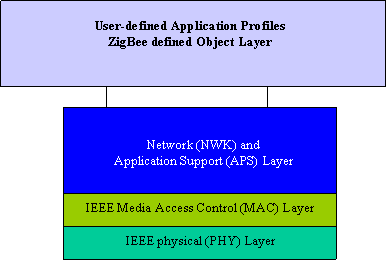You are here
Architecture
|
Though WPAN implies a reach of only a few meters, 30 feet in the case of ZigBee, the network will have several layers, so designed as to enable intrapersonal communication within the network, connection to a network of higher level and ultimately an uplink to the Web. The ZigBee Standard has evolved standardized sets of solutions, called ‘layers'. These layers facilitate the features that make ZigBee very attractive: low cost, easy implementation, reliable data transfer, short-range operations, very low power consumption and adequate security features. |
1. Network and Application Support layer : The network layer permits growth of network sans high power transmitters. This layer can handle huge numbers of nodes. This level in the ZigBee architecture includes the ZigBee Device Object (ZDO), user-defined application profile(s) and the Application Support (APS) sub-layer.
The APS sub-layer's responsibilities include maintenance of tables that enable matching between two devices and communication among them, and also discovery, the aspect that identifies other devices that operate in the operating space of any device.
The responsibility of determining the nature of the device (Coordinator / FFD or RFD) in the network, commencing and replying to binding requests and ensuring a secure relationship between devices rests with the ZDO (Zigbee Define Object). The user-defined application refers to the end device that conforms to the ZigBee Standard.
2. Physical (PHY) layer : The IEEE802.15.4 PHY physical layer accommodates high levels of integration by using direct sequence to permit simplicity in the analog circuitry and enable cheaper implementations.
3. Media access control (MAC) layer : The IEEE802.15.4 MAC media access control layer permits use of several topologies without introducing complexity and is meant to work with large numbers of devices.

Figure 1: IEEE 802.15.4 / ZigBee Stack Architecture [ZigBee: 'Wireless Control That Simply Works']
